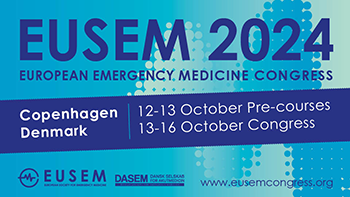
PRESS RELEASE
Embargo: 00.01 hrs CEST on Wednesday 16 October 2024
Increase in air pollution corresponds with more patients at the hospital emergency department
Copenhagen, Denmark: Increases in levels of particulate matter in the air, even within World Health Organization guidelines, correspond with an increase in the number of patients going to the hospital emergency department, according to research presented at the European Emergency Medicine Congress today (Wednesday).
The study found links particularly between air pollution and cases of trauma, breathing difficulties and skin conditions.
The research was presented by Dr Andrea Rossetto an emergency medicine resident at University of Florence and Careggi University Hospital, Florence, Italy, and a PhD Student at Queen Mary University of London, UK.
Dr Rossetto said: “We know that air pollution is damaging for health, especially in terms of breathing and lung diseases, and this is likely to have an impact on our health services. However, there is limited evidence on the impact of fluctuations in air pollution on the overall workload in the emergency department.”
Working with Dr Alessio Gnerucci from the Department of Physics and Astronomy, University of Florence, Italy, Dr Rossetto gathered data on patients admitted to the emergency department at Careggi University Hospital in Florence between 2019 and 2022. This included a total of 307,279 patient visits to the emergency department.
They compared this with data on the daily levels of particulate matter of less than 2.5 micrometres in size (PM2.5) and particulate matter of less than 10 micrometres (PM10) near patients’ home addresses for up to 30 days before they went to hospital.
The researchers found an increase in daily patients in the emergency department of 10-15% in the few days following an increase in levels of PM2.5 and PM10. In particular, cases of trauma, breathing difficulties and skin conditions increased in the days following rises in air pollution. Cases of trauma linked to air pollution were generally in younger patients, while in older patients (over 65) breathing difficulties linked to pollution were more common.
Dr Rossetto said: “In this study, we were able to estimate pollution in the air where patients live, and this revealed a strong connection between higher levels of particulate matter and visits to the emergency department.
“At our hospital most trauma patients have been involved in road traffic collisions. Traffic is also a primary driver of increased air pollution in urban areas. It is likely that heavy traffic is directly responsible for the increase in trauma cases and indirectly for more patients presenting with breathing difficulties linked to air pollution.
“This means we’re seeing more patients with breathing difficulties at a time when the emergency department is already under stress with more trauma cases, with potentially worse outcomes for such patients.”
The researchers say that more research is needed to see if a similar relationship between air pollution and emergency department admissions exists in other hospitals, for example, this study does not include children, who can be more susceptible to the effects of air pollution.
The researchers hope to carry out similar studies looking at the impact of levels of other pollutants in the air and weather patterns on visits to the emergency department, not only in terms of overall workload but also in relation to specific diseases.
Dr Barbra Backus is chair of the EUSEM abstract selection committee. She is an emergency physician in Rotterdam, The Netherlands, and was not involved with the research. She said: “This study adds to existing evidence that air pollution, even at concentrations within WHO guidelines, is harmful to our health and our health services. Understanding this link could allow hospitals to prepare for surges in patient numbers and take action to reduce overcrowding in the emergency department. Hopefully further research will provide even more information on this topic.
“However, if we want to protect our health and reduce the burden on hospitals, we need to do all we can to minimise emissions and reduce exposure to air pollution.”
(ends)
[1] Abstract no: POS0812, “Particulate matter and emergency department visits in the Florence urban area between 2019 and 2022: a time-series study” by Andrea Rossetto, poster presentation session, Wednesday 18 October, 11:00-12:30 hrs CEST, Room 18.
Funding: No external funding.
About European Society of Emergency Medicine (EUSEM)
The European Society for Emergency Medicine (EUSEM) is an academic, medical, non-profit society representing the interests of all healthcare professionals involved in Emergency Medicine across Europe. It has members consisting of 38 National European societies and over 1200 individual members. In total, through the different forms of membership, the society represents over 40000 Emergency Medicine Specialists. The scope of EUSEM is from prehospital to the clinical setting, encompassing the whole pathway for emergency medicine. Since 1994, EUSEM has organised a meeting for its members. The congress now attracts over 3000 participants from 76 countries. Its main objective is to share best practices, and to present the latest research and developments in the field in order to provide the best treatment and care for patients.
